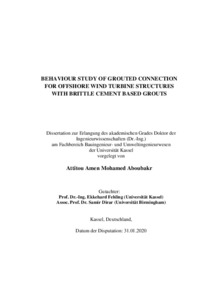| dc.date.accessioned | 2020-03-17T11:27:42Z | |
| dc.date.available | 2020-03-17T11:27:42Z | |
| dc.date.issued | 2020 | |
| dc.identifier | doi:10.17170/kobra-202003171085 | |
| dc.identifier.uri | http://hdl.handle.net/123456789/11488 | |
| dc.language.iso | eng | eng |
| dc.rights | Urheberrechtlich geschützt | |
| dc.rights.uri | https://rightsstatements.org/page/InC/1.0/ | |
| dc.subject | grouted connection | eng |
| dc.subject | offshore wind structures | eng |
| dc.subject | grout material using HPC and UHPC | eng |
| dc.subject | steel fiber | eng |
| dc.subject | arrangement of shear keys | eng |
| dc.subject | FE modelling | eng |
| dc.subject | stresses in the grout | eng |
| dc.subject | stresses in steel part | eng |
| dc.subject | design codes for grouted connection | eng |
| dc.subject.ddc | 620 | |
| dc.title | Behaviour Study of Grouted Connection for Offshore Wind Turbine Structures with Brittle Cement Based Grouts | eng |
| dc.type | Dissertation | |
| dcterms.abstract | Researches show that the energy demand in the world is significantly increasing and climate change becomes a problematic issue, therefore, the interest in renewable energy is growing extremely fast. Offshore wind energy is one of the most effective renewable sources in Europe and other places in the world. One of the most important parts in the offshore foundation is the grouted connection as it is the first element to be designed in the design of the foundation structure of an offshore wind turbine because the vertical length of the grout connection determines the total size of the transition part. Over the past two decades, the grouted connection has been used for an increasing number of offshore wind turbine structures.
The main aim of this thesis is to investigate the ultimate capacity of grouted connections under concentric and eccentric loading, with NC, HPC and UHPC grouts, different arrangements of shear keys and different connection geometry. To achieve this aim, an experimental program and numerical modelling were carried out. The result of the experimental program in chapter 4 was used as fundamental for the benchmark of the numerical model in chapter 5. Several specimens were required to complete this research therefore, 14 specimens were tested over a period of 18 months. Based on the experimental program and the analysis of results, design of the grouted connection could be developed. The research has focused on grouted connection behaviour and investigating the most important parameters through experimental tests and finite element modelling. Moreover, as of yet, there has only been a handful of studies, which have looked at the shear keys arrangement. For these reasons, the thesis addressed variations in the arrangement of shear keys and their effect on the connection capacity.
The main parameters, which affect the grouted connection behaviour according to the test results is summarized in chapter 6. The grouted connection behaviour as discussed in this chapter is highly dependent on grout material, type of loading and different arrangement of shear keys.
As an alternative to experimental testing, numerical modelling can be used. The numerical modelling was done using ATENA finite element program. After the validation of the numerical model, a stresses study was done. The stress checks were carried out in the highly stressed region near the shear keys and for the middle region of the compression struts, therefore, the stress checks was carried out for local principal stresses at shear keys, principal tensile stress and compression stresses.
There are many standards used for grouted connection design. One of the goals of this research was to look at current standards used to design the grouted connection. Nevertheless, one core issue should be investigated: How can these standards accommodate new grout materials such as HPC and UHPC. The applicability of the current design codes, which is described in chapter 7 was studied. Comparison was made with the predicted bond strengths derived from design codes (API, UKDE, NORSOK and DNV) and test results. The result of the comparison shows that some design codes formulae for grouted connections cannot be extrapolated to connection. | eng |
| dcterms.accessRights | open access | |
| dcterms.creator | Aboubakr, Attitou Amen Mohamed | |
| dcterms.dateAccepted | 2020-01-31 | |
| dcterms.extent | xxii, 242 Seiten | |
| dc.contributor.corporatename | Kassel, Universität Kassel, Fachbereich Bauingenieur- und Umweltingenieurwesen | |
| dc.contributor.referee | Fehling, Ekkehard (Prof. Dr.) | |
| dc.contributor.referee | Dirar, Samir (Prof. Dr.) | |
| dc.subject.swd | Windenergie | ger |
| dc.subject.swd | Offshorebauwerk | ger |
| dc.subject.swd | Windturbine | ger |
| dc.subject.swd | Stahlfaser | ger |
| dc.subject.swd | Belastung | ger |
| dc.type.version | publishedVersion | |
| kup.iskup | false | |

